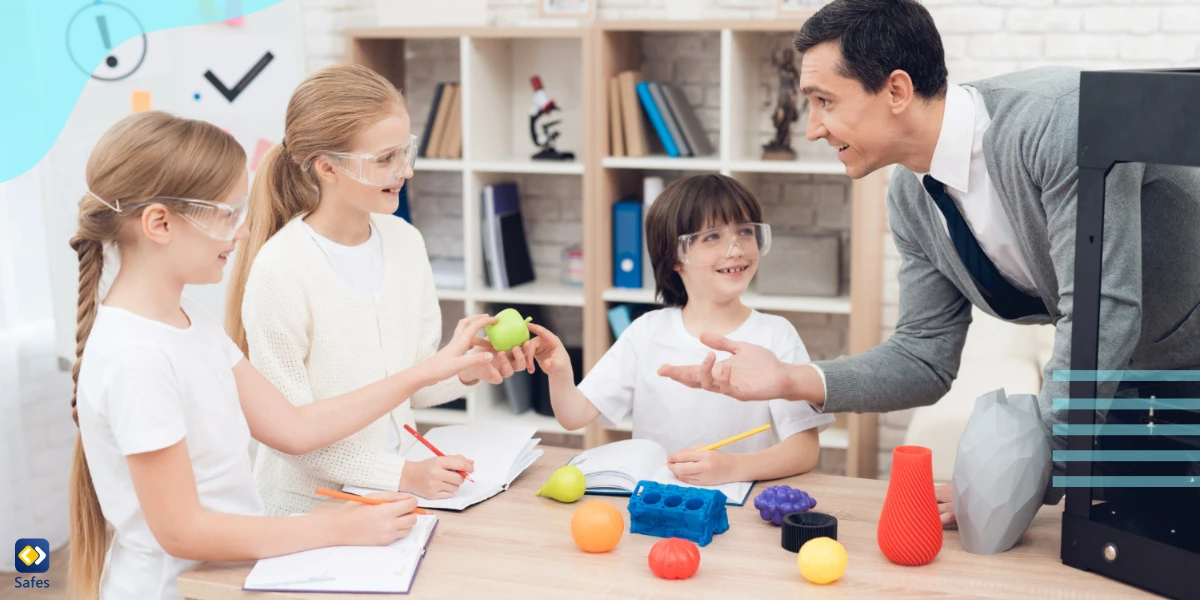As adults, we often take for granted the ability to plan, stay organized, and effectively manage our time. However, these crucial skills, known as executive functioning skills, are not innate and must be learned. Executive functioning skills are the mental processes that help us set goals, prioritize tasks, and regulate our thoughts and actions. They serve as the foundation for success in school, relationships, and life as a whole. In this blog post, we will delve into practical strategies and techniques on how to teach executive functioning skills to kids. We will explore engaging activities, effective routines, and supportive approaches that can foster the development of these essential skills. Whether you are a parent, teacher, or caregiver, our aim is to provide you with actionable guidance that will make a meaningful impact on the children in your care.
Download and Start Your Free Trial of the Safes Parental Control App
Understanding Executive Functioning Skills
Executive functioning skills refer to a set of cognitive abilities that enable individuals to effectively manage and regulate their thoughts, actions, and emotions to achieve goals and solve problems. These skills play a crucial role in various aspects of life, including academics, relationships, and daily tasks.
These skills are comprised of the following:
- Working Memory: The ability to hold and manipulate information in the mind while performing tasks.
- Cognitive Flexibility: Adapting and switching between different tasks or perspectives.
- Inhibitory Control: The skill to suppress impulsive behaviors and resist distractions.
- Self-Monitoring: The capability to reflect on one’s actions and adjust them accordingly.
- Planning and Organization: The aptitude to set goals, create strategies, and manage resources to accomplish tasks.
- Time Management: The ability to allocate time effectively and prioritize tasks accordingly.
- Emotional Regulation: The capacity to understand and manage emotions to respond appropriately to situations.
Developmental Milestones of Executive Functioning Skills
The developmental milestones of executive functioning skills vary across different age groups. Here is a general outline:
Preschool (3-5 years): Children begin to develop basic inhibitory control and working memory. They learn to follow simple instructions and engage in basic planning and organization tasks.
Elementary School (6-11 years): Executive functioning skills become more refined. Children enhance their working memory, cognitive flexibility, and self-monitoring abilities. They start to plan and organize tasks, manage time, and regulate their emotions more effectively.
Adolescence (12-18 years): Executive functioning skills continue to mature during this period. Teenagers demonstrate advanced cognitive flexibility, working memory, and self-monitoring skills. They become better at planning and organizing complex tasks, managing time, and regulating their emotions in various situations.
It’s important to note that these milestones are approximate and can vary from individual to individual.

Common Challenges in Executive Functioning Skills
Executive functioning difficulties in children can manifest in various ways. Some common signs include difficulty with organization and planning, forgetfulness, poor time management, trouble initiating tasks, being easily distracted, struggling with problem-solving, and difficulty regulating emotions and impulses.
These executive functioning challenges can significantly impact academic and social functioning. In terms of academics, children with executive functioning difficulties may struggle to complete assignments on time, have difficulty following multi-step directions, exhibit poor organizational skills, and struggle with time management. These challenges can lead to lower grades, incomplete or disorganized work, and difficulty staying focused in class.
In terms of social functioning, as researchers from the University of Extremadura note, children with executive functioning difficulties may have trouble with self-regulation, leading to impulsive behaviors and difficulty controlling their emotions. They may struggle with social skills such as taking turns, sharing, and problem-solving, which can impact their ability to make and maintain friendships. These challenges can also affect their ability to follow rules and routines, leading to conflicts with peers and authority figures.
Teaching Strategies for Executive Functioning Skills
Teaching executive functioning skills is crucial for helping children thrive academically and socially. These skills, such as working memory, cognitive flexibility, and self-monitoring, play a significant role in a child’s ability to plan, organize, and regulate their emotions. In the following, we will explore effective strategies for teaching executive functioning skills that can be easily implemented at home and in the classroom.
Strategies for Teaching Executive Functioning Skills
Break down tasks into manageable steps: Breaking down complex tasks into smaller, more manageable steps can help children develop their planning and organization skills. By teaching them to prioritize and tackle one step at a time, they can better understand the process and feel a sense of accomplishment as they complete each step.
Use visual aids and organizational tools: Visual aids, such as charts, calendars, and to-do lists, can be powerful tools for enhancing a child’s organizational skills. These visual cues provide a clear and tangible representation of tasks, deadlines, and important information, helping children stay focused and on track.
Teach goal-setting and time-management techniques: Goal-setting and time-management go hand in hand with executive functioning skills. By teaching children how to set realistic goals and create a schedule or timetable to manage their time effectively, they can develop a sense of responsibility and learn to prioritize tasks based on importance and urgency.
Encourage self-reflection and self-monitoring: Self-reflection and self-monitoring are vital components of executive functioning skills. Encourage children to reflect on their actions, emotions, and thought processes. By fostering self-awareness, they can better understand their strengths and weaknesses, allowing personal growth and improvement.
Promote problem-solving and decision-making skills: Providing opportunities for children to solve problems and make decisions independently can strengthen their cognitive flexibility and inhibitory control. Encourage them to think critically, weigh different options, and consider the potential consequences of their choices. This will foster their ability to adapt to new situations and make informed decisions.

Incorporating Executive Functioning Skills in Classroom
Incorporating executive functioning skills in the classroom can greatly benefit students by equipping them with essential tools for academic success and beyond. These skills, such as organization, time management, and self-regulation, are crucial in a student’s ability to focus, problem-solve, and work independently. By intentionally incorporating executive functioning skills into our teaching practices, we can empower our students to become more efficient, confident, and resilient learners.
Steps to Incorporating Executive Functioning Skills in the Classroom
Creating a Structured and Predictable Environment: Establishing a structured and predictable classroom environment provides a solid foundation for students to develop executive functioning skills. Clear expectations, consistent routines, and designated spaces for materials and supplies help students understand what is required of them and reduce anxiety. Students can better manage their time, prioritize tasks, and stay organized by creating a predictable environment.
Implementing Routines and Schedules: Routines and schedules provide students with a sense of stability and help them develop important executive functioning skills such as time management and planning. Incorporate regular routines for starting and ending the day, transitioning between activities, and organizing materials. Display visual schedules and timers to help students understand and manage their time effectively.
Providing Clear Instructions and Expectations: Clear and concise instructions are essential for students to understand tasks and expectations. Break down complex tasks into smaller, manageable steps, and provide visual aids or checklists to assist students in following directions. Clearly communicate the goals and objectives of each activity, and provide examples or models to support student comprehension.
Offering Support and Accommodations for Students with Executive Functioning Difficulties: Recognize that some students may have executive functioning difficulties and require additional support. Individualized accommodations, such as providing visual prompts, using graphic organizers, or offering flexible deadlines, can help students with executive functioning challenges succeed in the classroom. Regular check-ins, goal-setting, and feedback can also promote self-reflection and growth.
Collaborating with Parents and Guardians
Communication and partnership with parents are crucial in teaching kids executive functioning skills. Open and frequent communication with parents allows for exchanging information about a child’s progress, challenges, and successes. Doing this helps create a shared understanding of the child’s executive functioning needs. It allows for tailored support at home and in the classroom.
Also, involving parents in the teaching process empowers them to reinforce and practice executive functioning skills at home. By providing parents with strategies and resources, they can actively participate in their child’s learning journey.
Strategies for Fostering Executive Functioning at Home
Here are some strategies that schools and educators can teach parents so that they can develop their children’s executive functioning skills at home:
Establish routines and schedules: Encourage parents to create consistent daily routines and schedules that help children develop time management and organization skills.
Break down tasks: Teach parents how to break tasks into manageable steps, guiding children through planning, prioritizing, and completing assignments independently.
Use visual aids: Suggest using visual aids such as calendars, checklists, and charts to assist children in understanding and following through with tasks and responsibilities.
Encourage goal-setting: Help parents guide their children in setting realistic short-term and long-term goals. Regularly reviewing and adjusting these goals can teach children perseverance and self-motivation.
Teach problem-solving skills: Share strategies with parents on how to encourage their children to think critically, solve problems independently, and make decisions by weighing pros and cons.
Promote self-reflection and self-monitoring: Encourage parents to engage in conversations with their children to reflect on their actions, emotions, and behaviors. This fosters self-awareness and self-regulation skills.
Provide a supportive environment: Emphasize the importance of creating a supportive and nurturing environment at home, where mistakes are seen as learning opportunities and children feel encouraged to take risks and develop resilience.

Leveraging Technology and Parental Control Apps
Technology-based tools can be a game-changer in supporting executive functioning skills. Various apps and software available can assist children in managing tasks, staying organized, and effectively allocating their time. These tools provide a digital solution to help kids with executive functioning difficulties.
One popular category of apps is parental control apps. These apps offer features for monitoring and limiting screen time and provide tools for managing tasks and time allocation. Parents can set up reminders, create schedules, and establish routines for their children using these apps. Some even allow parents to assign tasks and track their completion.
Task management apps are another great option for supporting executive functioning skills. They help children break down tasks into smaller, manageable steps. They provide visual aids, such as to-do lists and progress trackers, to keep kids on track and motivated. Some even offer features like reminders and notifications to ensure that tasks are completed on time.
Time management apps are also worth considering since they can help your child allocate their time effectively by setting timers, creating schedules, and organizing their day. They can assist in prioritizing tasks, setting goals, and managing distractions. Some apps even have features like Pomodoro timers, which break work into intervals with short breaks in between to enhance focus and productivity.
How Can Safes Help Your Kid with Executive Functioning Skills?
The Safes parental control app is a practical tool for parents looking to support their children in developing executive functioning skills. With its user-friendly interface and comprehensive features, Safes assists you in creating a structured and organized digital environment for your kid.
Safes offers a screen time management feature. You can set limits on device usage, promoting healthy habits and preventing excessive screen time. By helping your kid balance their online activities and offline responsibilities, Safes teaches them self-regulation and time allocation skills.
Another valuable aspect of Safes is its content filtering and blocking capabilities. You can ensure that your child is accessing age-appropriate and educational content while blocking inappropriate or distracting websites, apps, and search keywords. By creating a safe digital environment, Safes helps children develop focus and concentration skills.
Furthermore, Safes provides insightful reports and analytics, allowing you to track your child’s digital habits and identify areas for improvement. By reviewing these reports together, you and your child can have meaningful discussions about responsible digital usage and goal setting.
Safes is available on all Android, iOS, Windows, and Mac devices. To learn how to put parental controls on different platforms using Safes, follow the links below:
- Windows parental controls
- Macbook parental controls
- Parental controls on Android
- iPhone parental controls
Conclusion: How to Teach Executive Functioning Skills?
In this blog post, we explored the significance of teaching executive functioning skills to children and provided practical strategies on how to teach these skills effectively. We discussed the developmental milestones of executive functioning skills, identified signs of difficulties, and their impact on academic and social functioning. Additionally, we emphasized the importance of collaboration with parents, shared teaching strategies for the classroom, and highlighted the role of technology-based tools in supporting the development of executive functioning skills. By implementing these strategies and fostering a supportive environment, we can empower children with the essential skills they need to succeed academically and in their daily lives.
Your Child’s Online Safety Starts Here
Every parent today needs a solution to manage screen time and keep their child safe online.
Without the right tools, digital risks and excessive screen time can impact children's well-being. Safes helps parents set healthy boundaries, monitor activity, and protect kids from online dangers—all with an easy-to-use app.
Take control of your child’s digital world. Learn more about Safes or download the app to start your free trial today!




